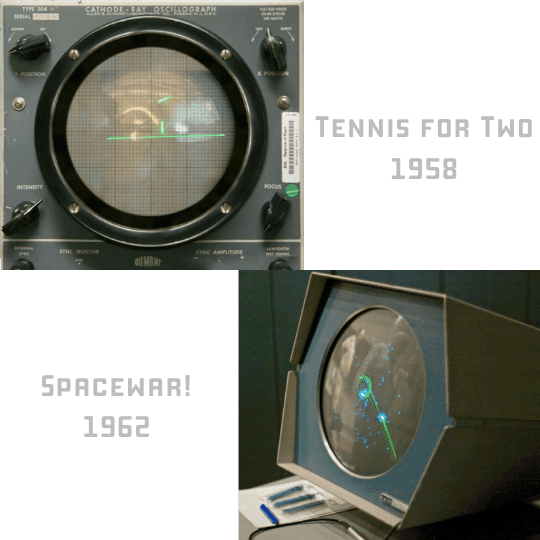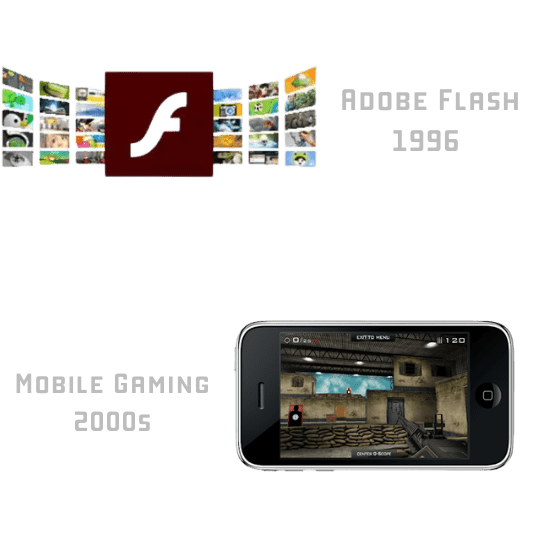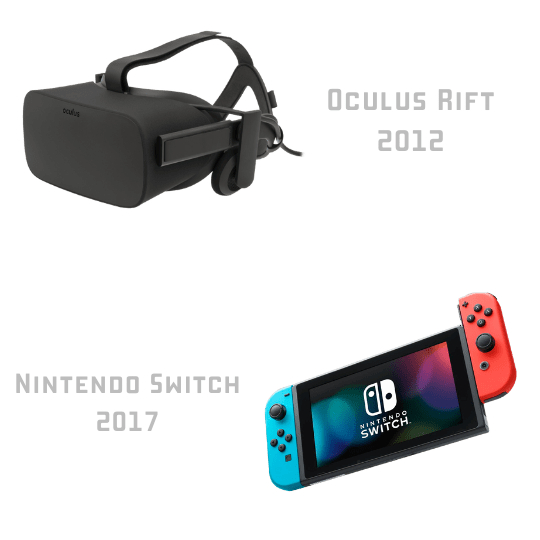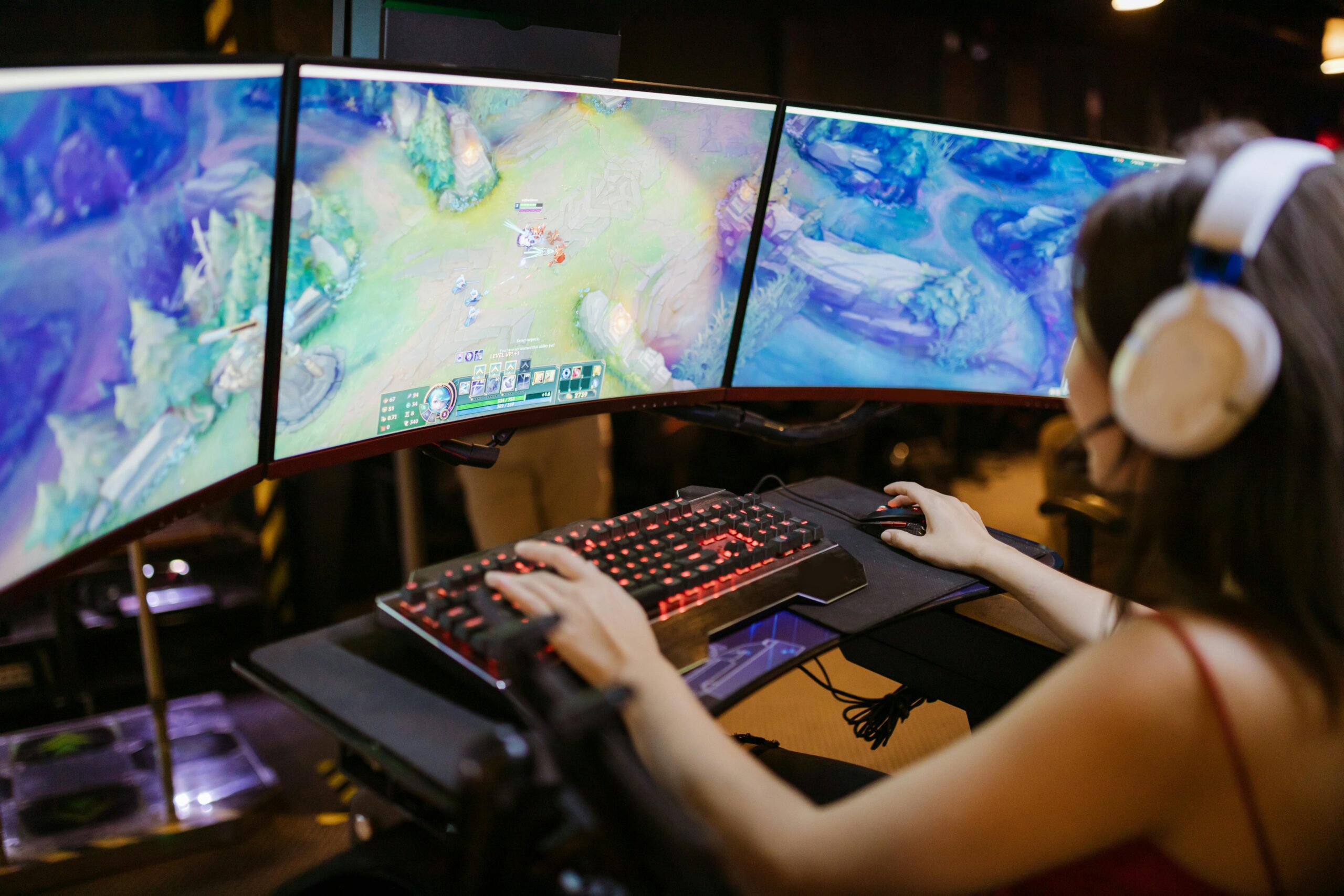So I think we can all agree – if we’re here on this website, we like video games. But have you ever thought about how video games were first created? If not, you are in for a surprise!
1950s & 1960s
The 50s isn’t a time period you think of when it comes to video game history but it actually marks the start. The first video games were created on what were some of the earliest analogue computers ever built in an effort to showcase the computers’ capabilities. 1958 is when the first video game, Tennis for Two, is created. Other notable games created on these computers are Tic-Tac-Toe and Nim.
Computer games were being created in the 60s but due to a scarcity of computers as well as the difficulty of transferring the games onto computers in different locations, none of them really spread beyond the college campus they were created on. The exception being Spacewar! which was created by a group of students at MIT and spread across the country, gaining popularity.

1970s

Video games really start picking up in the 70s. Atari was founded in 1972 and their game, Pong, becomes a global success. The first commercialized home console, the Magnavox Odyssey, also was released in ’72. In 1974, the first ever variation of a First Person Shooter game, Maze Wars, came out – although the term “first person shooter” didn’t get popular until the 2000s.
The 70s is also the time period where video game cabinets came out to a broader audience for a low price. Space Invaders came out for these cabinets which brought on the golden age of arcade which lasted from 1978-1982.
1980s
The 80s brought the wide spread of home computers. Clones of popular arcade games were created and were being distributed as code through books, magazines, and newsletters. Unfortunately, 1983 brought the video game crash. With an influx of poor quality games in the American gaming market, the once popular Atari brand was struggling and gaming consoles such as the Magnavox and the ColecoVision, which had only been released the year before, to be discontinued.
The crash also affected the arcade and home computer business but luckily, the computer business didn’t suffer as much. By 1984, PC gaming began dominating console gaming. The Apple Macintosh was also launched that year, leading to the next wave of home computers in the late 80s that had advanced graphics and sound.
Nintendo wanted to release their Famicom to the American audience since it was doing so well in Japan, but they were unsure because of the state of the game console market. They decided to rebrand the Famicom to the Nintendo Entertainment System (NES) and launched it in the US. In only 4 years, the NES managed to bring a resurgence of the video game console industry in the United States.

1990s

We saw a huge improvement of video games start in this decade. Video game graphics went from raster to 3D and game consoles such as the PlayStation, Sega Saturn, and Nintendo 64 were able to produce texture-mapped 3D graphics. Several genres including FPS, MMOs, and real-time strategy started to rise and other notable genres that gained popularity were simulation games, survival horrors, and MMORPGs.
While home consoles were skyrocketing, arcade games were declining. Even with arcade games seeing a comeback due to the popularization of one-on-one fighting games, the revival quickly died out due to the controversy of violent video games along with the fact that video game consoles were getting ports of everyone’s favorite arcade games. Arcade games tried to up their graphics to combat this, but game consoles quickly followed suit.
The 90s were also when handheld consoles entered the market. The Nintendo Gameboy was released in 1989 with several other handheld game systems following in its footsteps. No other handheld gaming system could match that of the Gameboy though, so it went virtually unrivaled in the 90s.
2000s
There were huge innovations made to console and PC games. Game consoles released in the 2000s came with features such as the capability to support DVD and CD formats, backwards compatibility, and the ability to connect to the internet to play games online.
As the internet became more available to the public, online games such as Runescape, World of Warcraft, and many more became very popular. And with the accessibility of the internet and programs such as Java and Adobe Flash came a wave of browser games which were available for casual gamers to play for free. Soon social media started implementing these casual games which relied on users to interact with their friends on social media in order to gain in-game items.
The handheld console market was still doing quite well. The Nintendo DS was released in 2004 and soon after the PSP was launched. While the PSP boasted better graphics and power, the Nintendo DS focused more on the novelty of the system with its two screen system.
Mobile gaming also started rising with the introduction of smart phones and the app store. By 2009. the freemium model was introduced to mobile gaming, where the game is initially free but to speed up the process or get extra items, the player must pay a small premium.

2010s

The emergence of gaming consoles with updated graphics to match the capabilities of the new flat screen TVs that were becoming popular. PlayStation and Xbox consoles were extremely popular well but Nintendo’s Wii U was a commercial failure due to bad marketing.
Nintendo’s portable consoles were still successful. They upgraded the DS, to DSi, to the 3Ds and New 3Ds, and then eventually they created the switch, which worked as both a portable console and home console when docked. Sony released the PlayStation Vita, but it was soon discontinued due to poor performance. Sony stated that they would not be working on any portable consoles in the future.
Personal computers, on the other hand, were doing really well during this time period. PC graphics cards were constantly upgrade past that of the performance of consoles and powerful graphics cards began gaining popularity with cryptocoin miners.
VR gaming also became popular due to products such as the Oculus Rift and HTC Vive hitting the consumer market.
2020s
Though the 2020s are still young, we’ve still seen some breakthrough with graphics. Graphics cards now have the ability to support real-time ray tracing – a feature already on home consoles released that year. There has also been significant improvements in the ability to display highly detailed graphics which allow for photorealism in games.
So, did you learn anything new about video games? Let us know on Facebook!




Recent Comments